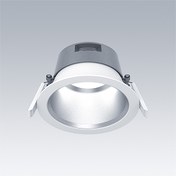Chalice 3 / CHAL3 150 3000-840 EHF RSB
96108664
▼ Datenblatt
Ein hocheffizientes und nachhaltiges LED-Downlight mit geringer Höhe. Geeignet zur Montage in Decken mit einer Stärke von 1 bis 40 mm in einem Ausschnitt von Ø 150 mm mit Haltefedern. Separates, steckbaresNicht dimmbare Betriebsgerät, mit DC-Funktion, einstellbar 50-100 %, NFC konfigurierbar. Durchgangsverdrahtung möglich. Gehäuse: AluminiumDruckguss für hocheffizientes Wärmemanagement mit einem Recyclinganteil von > 90 %. Diffusor: Polycarbonat (PC). Reflektor und Ring: Polycarbonat (PC) glatter Reflektor, satiniert, breitstrahlend. Schutzklasse II, IP20. Inklusive LED-Modul mit 4000K
Einbau in Betondecken nicht zulässig.
Abmessungen: Ø174 x 94 mm
Leuchten Leistung: 27,5 W
Leuchten Lichtstrom: 3130 lm
Leuchten Lichtausbeute: 114 lm/W
Gewicht: 0,68 kg
- LED
- BEG
- CE
- NoIsol
- ENEC11
- GLedReP
- 850°
- Halogenfrei
- IK09
- IP54_IP20
- LLedReP
- RG1
- SC2 - Schutzklasse 2
- Ta=25

